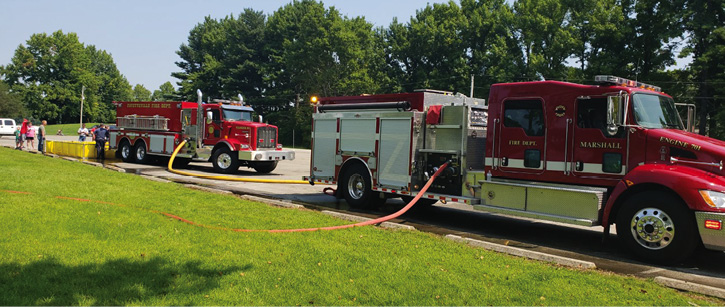
By Bill Adkins
It’s important when setting up your apparatus that you set it up for success. City engine companies, for example, set up apparatus for making the stretch easier, as city ladder companies set up their apparatus for ventilation, forcible entry, and search.
In the rural communities, it’s not much different. We load our hose so that it pulls easily. We buy and mount tools needed to complete any task we may face. We do this because we know that seconds count; however, I have noticed in years past that we don’t always do the same for our tankers/tenders. Fire departments tend to throw whatever extra tools they have into water supply apparatus. Some feel water supply apparatus is for shuttling water only. In some cases, tankers are for shuttling water from the source to the scene. In other cases, however, tankers play a more predominant role. In either scenario, the apparatus should be set up for a more simplified operation. In this article, we will discuss both situations—from shuttling tankers to pumper-tankers in a nurse tanker operation.
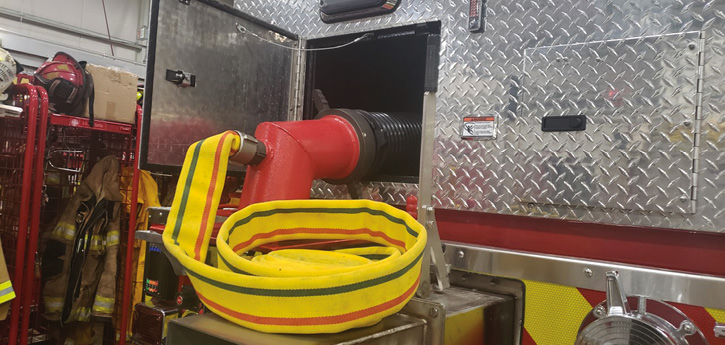
1 We had the hard suction hosebed with a large box to house the low-profile strainer and a 20-foot section of 1¾-inch hose to set up the jet syphon quickly and easily. (Photos by author.)
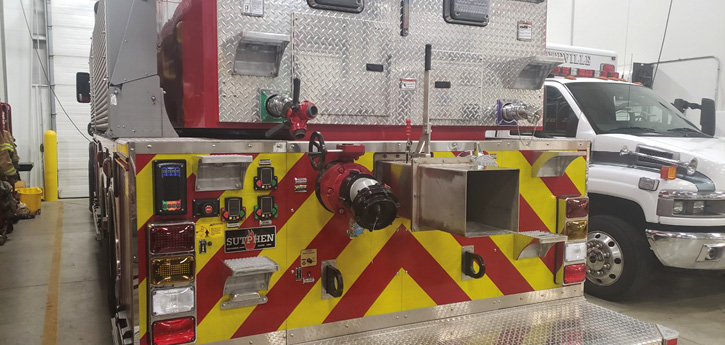
2 The rear of the apparatus has a remote pump panel for drafting from the rear of the tanker. The valves we chose were the large-diameter discharge (for relay pumping), the rear 2½-inch discharge (for jet syphoning), the rear intake valve, and a tank-to-pump valve.
Shuttling Tankers
Some of our colleagues don’t put much thought into the options of shuttling water faster and simpler. Let’s consider some of the conditions you may find yourself in when operating a shuttling tanker: Which water source will you most likely use for your water? Is it a fire hydrant? If so, be sure to know if your fire hydrants have 4½-inch steamers with 2½-inch discharges or just have 2½-inch discharges. Are you drafting your water from a static water source, or are you obtaining your water from a filling station? It’s important to explore this, as many fires happen at night. When shuttling water, you may be doing a lot of backing. Therefore, think about lighting and aides to help with backing apparatus.
When filling your apparatus, be sure to use whatever will fill your tanker in the most gallons per minute (gpm). For example, when using a fire hydrant, consider large-diameter hose (LDH) instead of 2½- or 3-inch hose. Consider the same when filling from a filling station. If your shuttling tanker has a pump and drafting is needed to fill, try to use larger hard suction. Although 3-inch suction hose may pull a draft easier, you will find that using the larger (5- or 6-inch) suction hose will fill your tanker faster. Keep in mind you may be the only tanker with a pump. Setting up a filling station with the tanker or an engine would dramatically decrease filling times.
When equipping a shuttling tanker, I like to make sure it has what it needs to make shorter turnaround times:
- A direct tank fill with fittings (already attached) from 5-inch Storz to 2½-inch.
- Spanner and hydrant wrenches mounted close to each discharge and intake.
- Adequate scene lighting on all sides of the tanker.
- A dump tank large enough to empty the tank (if the tanker has a 3,000-gallon tank, equip it with a 3,000-gallon dump tank).
In addition, I also like to have 50-foot rolls of 3-inch and 5-inch hose. This makes it easier for one firefighter to deploy and reload hose (once the incident is complete) when attaching to a hydrant. Dump valves are needed on three sides of the vehicle. A Newton Kwik-Dump valve, including a model 1070 gate-style valve with a swivel chute, is an inexpensive option.
Nurse Tankers
Nurse tankers generally don’t shuttle water. They are set up to supply the first-due apparatus. When setting up a nurse tanker, consider the conditions you will face. When staffing is optimal, there could be two or three firefighters on the tanker. Many times, the tanker arrives with one firefighter. We like to prepare for the worst-case scenario in the fire service; therefore, I like to set up the nurse tanker so one firefighter can set up nurse tanker operations.

3 Nurse tanker operations: Tanker ٨٥ is drafting from the dump tank and relay pumping to the first-due apparatus.
Nurse tankers should be equipped to supply as much water as possible to the first-due apparatus. For the first few minutes, the nurse tanker will be using its own tank water to supply the first-due apparatus. This requires the nurse tanker to be able to supply large amounts of water. Standard tank-to-pump valves are 3-inch. This only allows approximately 700 gpm. For most fires, that will be enough; however, your first-due apparatus may require more gpm for larger fires. In this case, I recommend you spec a second tank-to-pump or larger valve when building your nurse tanker. Having a 4- or 5-inch discharge instead of the common 2½-inch discharge helps with delivering more gpm.
One of the biggest challenges for setting up the nurse tanker operation when only one firefighter is available is setting up the dump tank. Let’s face it: When there is a large fire in a rural area, we need to place a dump tank on the ground. A great way to aid a firefighter is a hydraulic-aided dump tank device to help lower the dump tank to the ground. The firefighter can then use gravity to take the dump tank out and to the ground.
Making sure everything is airtight for drafting is another challenge when only one firefighter is available. If you have ever tried putting hard suction and a strainer together by yourself, then you know what I’m talking about. I have found that keeping the strainer and hard suction hose together when stored on the apparatus helps with this dilemma. Connecting two or more hard suction hoses together would be the only time this difficult task would be needed. When you spec a nurse tanker, it helps to have an intake on as many sides of the apparatus as possible. This may prevent you from needing to connect more than one hard suction hose together. For example, if you are trying to keep a lane of the road open and you place the dump tank in the back of your nurse tanker, it helps to have an intake on the rear of the apparatus. If your intake is only on the side, you will most likely need to attach two hard suction hoses.
When equipping a nurse tanker, I like to make sure it has the equipment it needs for the task at hand. Make sure you have mounted spanner and hydrant wrenches around the intakes and discharges. Intake valves on all intakes help prevent water loss when connecting to draft from a dump tank. I still like to keep 50 feet of 5-inch and 3-inch hose for hydrant connections. A radio to keep in contact with the first-due apparatus is also a must.
Pumper-Tanker 85
At the Fayetteville (OH) Fire Department, we were fortunate to be able to spec and purchase a nurse tanker to make rural water movement easy for the operator. We have two 2006 pumpers that are in great shape. Instead of replacing those with a new pumper, per the National Fire Protection Association’s 15-year rule, we decided to have a pumper-tanker built in 2018. We wanted the pumper-tanker to be able to carry all the required equipment to classify as a Class 1 pumper and a tanker.
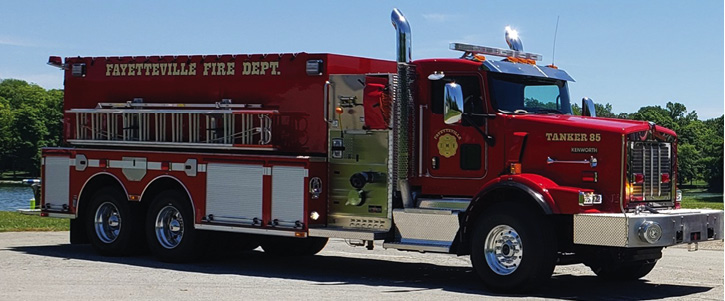
4 Tanker 85: two pump panels, 3,000 gallons, 1,500-gpm pump, two 4-inch tank-to-pump valves for high-volume flow when using tank to pump, and all the necessary equipment to classify as a pumper.
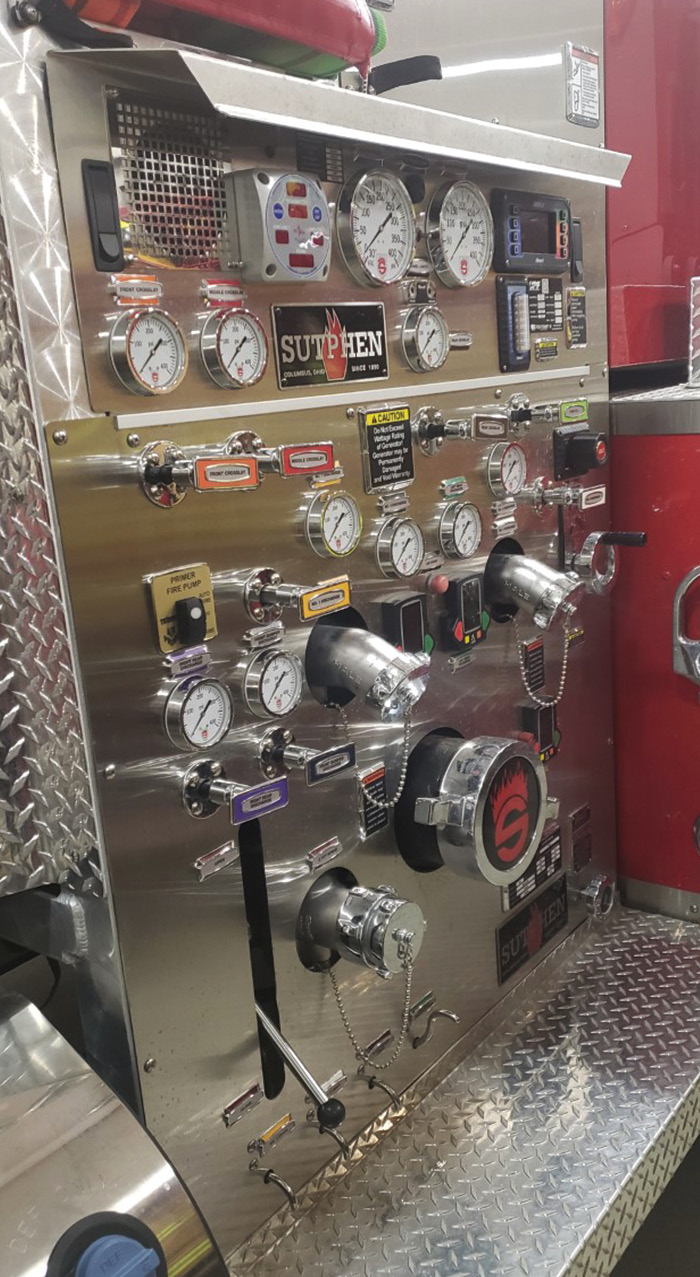
5 The side pump panel; all valves can be operated from this area.

6 Large-diameter discharge for relay pumping.
There are numerous ways to establish a nurse tanker operation; however, at Fayetteville, we set up a dump tank behind the nurse tanker so other tankers can shuttle water. Because of this, we decided to put a pump intake on the rear of the tanker. Our older pumper-tanker only had side pump intakes. This ensured we would need two hard suction sections to establish a water supply from our dump tank. With the rear pump intake, we now only need one hard suction hose. We also like to jet syphon to draft our water, so we added a compartment large enough to house the low-profile strainer with jet syphon to already be attached together. Now, we can pull out the suction hose and attach it to the pump intake. Then, we are ready to pull a draft.
Our operators like to see their suction hose when pulling a draft. This not only enables them to hear the pump as it pulls its draft, but it also allows the operator to see the water come into the pump. To accommodate our operators, we designed our tanker to have a remote pump panel at the rear of the tanker. The rear remote pump panel has a pump intake valve, a large-diameter discharge valve, a rear discharge valve, a tank-to-pump valve, a primer, and an electronic control panel.
As I mentioned earlier, when using the tank to pump from your nurse tanker, the maximum gpm would be around 700. Because of this, we added two 4-inch tank-to-pump valves. This gives us the option to flow close to 1,500 gpm when using the tank to pump. Another advantage this gives us when parking on a hill is that the forward or rear tank to pump will allow us to use almost all our tank water. If there is only a front tank-to-pump valve and you are parking uphill, you may not be able to use all your tank water.
Some other options include a hydraulic-aided dump tank carrier, a 4-inch discharge (for high gpm demand), a hydraulic generator, a front bumper hose compartment, three crosslays, and LED scene lighting on all sides of the apparatus. We also added the required equipment to classify the tanker as a pumper. This allows us to continue to use our 2006 pumpers without needing to replace them for years to come.
In the fire service, we set our apparatus up for quick deployments. Our tools, SCBA, and hose loads are set up to give our firefighters the best chance of success. In rural areas, we rely on water shuttles to be successful. Take the time to set up your tanker for the different tasks in rural water movement. You will find this aids in quicker turnaround times for needed water.
BILL ADKINS, a 25-year veteran of the fire service, is a captain in the Loveland-Symmes (OH) Fire Department and a volunteer assistant chief/training officer for the Fayetteville (OH) Fire Department. He joined the Navy after high school and became a diesel mechanic and nozzleman for the “At Sea Fire Party” and “In Port Emergency Team.” He served two tours in the Middle East and was a mechanic for the Army National Guard. He attended fire school at Scarlet Oaks, where he became firefighter 2 certified; he graduated paramedic school at the University of Cincinnati in 2007. He is a certified fire instructor, aircraft rescue firefighter, rescue technician, swift water technician II, and dive rescue specialist.

